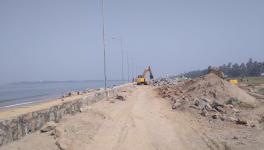LG Vizag Styrene Leak: Unabated Corporate-Regulatory Collusion

Image Courtesy: Scroll.in
The horrific leak of Styrene vapour from the LG Polymers plant in Vizag in the early hours of May 7, 2020, causing at least 13 deaths and serious injuries to several hundreds of people near the plant, has revived memories of the Bhopal Gas Disaster in December 2004.
Like in Bhopal, the LG plant was once in the city suburbs, but dense habitations had been allowed to come up in its vicinity. The Bhopal tragedy was, of course, far larger in scope and scale, as regards deaths and disabilities, including long-term effects on victims and on their children to come. Yet the parallels are striking in important ways.
The Bhopal Disaster triggered a slew of environmental regulations, especially as regards hazardous materials and industries using them. It is shocking, though, that almost four decades later, India is witnessing the same gross flouting of rules and regulations and, worst of all, a systemic collusion between regulatory agencies and corporate entities, making a mockery of these very protections for the environment and for people.
The LG Vizag plant was operating in knowing violation of environmental regulations, with regulatory agencies either turning a blind eye or passing the buck between themselves. Ironically this incident draws attention to the proposed Environment Impact Assessment (EIA) Notification 2020 written about in these columns just last week, which seeks to condone and give post-facto legitimacy to precisely the kinds of violations the LG plant committed.
The LG Vizag Styrene leak is a text-book case study of this systemic fraud in environmental governance in India.
Styrene & Health Effects
Styrene is among the top 20 hydrocarbons used industrially worldwide, to produce a variety of materials, such as polysterene, expanded polystyrene (EP) and enhanced plastic compounds (EPC) used for products in refrigeration, fibre glass and other composites, food containers, electrical insulation, synthetic rubber and so on. Under the Manufacture, Storage and Import of Hazardous Chemicals Rules, 1989, Styrene is classified as a toxic and hazardous chemical.
Styrene is normally a liquid, mistakenly referred to in much recent media coverage as a gas. It is flammable and gets easily vaporised even at low temperatures. Styrene is a monomer i.e., a single molecule that combines with other molecules to form polymers or chains of molecules.
Styrene occurs naturally in fruits and vegetables, meats, cinnamon, coffee and peanuts, and is also produced by plants, bacteria and fungi. It is present in combustion products, such as automobile exhaust and cigarette smoke, and is also released from photocopiers and styrene-using industries.
So, our everyday air contains styrene, albeit at a low background level of 0.06-4.6 ppb (parts per billion) outdoors, with automobiles contributing about the same proportion as industries. Indoor air usually contains higher levels of 0.07-11.5 ppb, mostly due to cigarette smoke.
Health effects of exposure to Styrene have been studied mostly in occupational contexts, resulting mostly from inhalation of Styrene vapours and, to a far lesser extent, contact with skin. Effects are mainly on the nervous system, and the symptoms include fatigue, loss of concentration and balance, slow reaction times and a feeling of being drunk. However these effects occur only at 1000 times or more Styrene than background levels. The US Occupational Safety and Health Authority (OSHA) has set a legal limit of 100 ppm Styrene in air over an eight-hour work day in workplaces. Average exposure of workers rarely exceeds 20ppm. A few studies have described inhalation of 360ppm Styrene for 30 minutes as “acute exposure.”
The International Agency for Research on Cancer (IARC) and other agencies say Styrene is a possible carcinogen, but not conclusively. There are also no definitive findings on possible birth defects, still births or low birth weight.
Once in the body, Styrene is converted into other compounds that are usually excreted in urine over a few days. Styrene absorbed in water bodies and soil is degraded quickly by different micro-organisms.
However, the massive leak of Styrene vapours over several hours on May 7, would have led to far higher levels of exposure, especially near the LG plant. Local media reported levels of around 700ppm. One study by experts at IIT Kanpur, as reported by the Centre for Science & Environment, has estimated that Styrene vapours would have had significant impact over 2-3 km downwind of the plant, with levels of about 1,100ppm in the immediate vicinity, 130ppm in a 1-km radius, and 20ppm at 2-3 km from the plant with exposure of two hours or more.
Such high exposures have not been known or studied earlier. Therefore, the short-term and long-term effects on people, as well as on milch animals, poultry, vegetables and plants, now need to be systematically investigated and mitigated.
Leak at Vizag LG Plant
This section on how and why the leak took place relies mainly on published material from different media outlets, some independent studies, and the industrial and scientific literature. All details of the sequence of events are not known yet, but some aspects are reasonably clear.
The LG plant used liquid Styrene stored in large tanks. The stored Styrene was supposed to be maintained at 20 degrees Celsius, but the temperature controls failed for reasons yet to be determined, and temperatures in the tank started rising. Auto-polymerisation inhibitors were apparently also not used as they were supposed to be. Inhibitors like Tetra Butyl-Catechol (TBC) used here, are normally used during storage and transportation of Styrene to prevent a self-driven process of polymerisation, that is, transformation of styrene monomer into polymers.
Auto-polymerisation is an exothermic process, meaning it releases heat, which further accelerates polymerisation, vaporisation of styrene, and vapour pressure. The danger is of a runaway reaction, which begins around 65 C and turns extreme if temperatures exceed the boiling point of styrene 145 C.
On May 7, auto-polymerisation appears to have taken place in the tank due to lack of temperature control, Styrene vapours were generated at increasing rates as both temperatures and vapour pressure inside the tank rose rapidly. If the safety valve, like the “weight” in a pressure cooker, had not worked, an explosion would have resulted. As it happened, the safety valve blew, releasing Styrene vapours high into the air over a prolonged period till measures to lower the temperature were taken. Temperatures are said to have exceeded 180 C, and were only slowly brought below a relatively safe level of 100C, and then to 78C.
After the incident, tons of inhibitors and other stabilising chemicals were flown in to Vizag on IAF transporters. All the Styrene in the tank had been converted to solid and stable polymers. The remaining styrene stocks, including thousands of tonnes stored at Vizag port, were scheduled to be re-exported either to Singapore or to the LG headquarters in Seoul.
There are reports that skilled workers were not available on site, but this may also be a management tactic to blame the incident on “human error.” The condition of bulk-stored Styrene is supposed to be monitored regularly, especially with respect to temperature and quantities of inhibitor, oxygen and polymers that may have formed.
Some reports have also spoken of problems with other sensors for Volatile Organic Compounds (VOC). Prolonged storage in the absence of effective monitoring may also have led to formation of polymers that may have clogged valves, pipelines, gauges and controls. Whether necessary precautions were taken, supervised and ensured is not known.
All these possible failures and weaknesses, and the causes and sequences of events, will hopefully be established soon by the inquiry team set up by the National Green Tribunal (NGT) or by other inquiries in future.
Two key issues have been insufficiently addressed so far. First, the LG plant should have conducted safety audits and drills, and trial runs before restarting operations. Second, and ideally, the plant should have been allowed to run till the stored Styrene had been exhausted, obviating prolonged storage and attendant dangers. But the lockdown had been announced with just for hours’ notice, negating this option, yet another bitter lesson of the consequences of a sudden lockdown with inadequate notice and preparations.
In belated acknowledgement of the dangers posed, the Central government has, but only after the Vizag leak, announced guidelines for chemical industries to conduct safety drills, test runs and gradual build-up to full-scale operations.
Regulatory Violations
The most shocking aspect of the Vizag LG plant case is the scandalous violations of environment regulations by LG and the casual attitude or even collusion by the authorities.
The plant in Vizag was first established in 1965 by Hindustan Polymers. It was taken over by McDowell & Company in 1982, later a part of the liquor giant UB Group. LG acquired the plant in 1997, but using imported Styrene. LG obtained consents for establishment and operation from the Andhra Pradesh Pollution Control Board (APPCB) in November 2001 and May 2002 respectively, before the Environment Impact Assessment (EAIA) Notification 2006, requiring prior environmental clearance (EC) had come into effect. However, when LG wanted to expand plant capacity from 415 TPD (tonnes per day) to 655 TPD, it had to seek prior EC for which it applied to the State Environment Impact Assessment Authority (SEIAA) in 2018. In September 2018, SEIAA objected on the grounds that the plant had been operating without EC.
In a notarised affidavit filed with the SEIAA later in May 2019, now reproduced in many newspapers, LG admitted that it had earlier undertaken six rounds of “minor expansions” of plant capacity, for expandable polystyrene from 45 to 102 TPD and for polystyrene from 235 to 313 TPD, between 2004 and 2017 without prior EC, in violation of the EIA 2006 Notification, but surprisingly with permissions from APPCB. These permissions by the APPCB, clearly bypassing the SEIAA, for which the APPCB acts as the Secretariat but without the powers of the Authority itself, are probably illegal, as affirmed by many experts in environmental law.
LG argued that the EIA Notification 2006 did not apply to its type of plant, and that the State authority was authorised to decide on Category B projects applicable to the LG Vizag plant. However, SEIAA referred the matter to the Union Ministry of Environment, saying the plant fell under Category A which required EC from the Centre.
Officials of the Environment Ministry in Delhi are reported in sections of the press to have claimed that there was confusion about whether the Centre or state was to grant the EC, but did not comment on how the plant had been operating so long without EC, except to casually say this “would be investigated.”
Peculiarly, LG seems to have withdrawn its application to the Ministry for expansion, and the Ministry’s website has a “Deleted” entry dated November 2019 with a noting that LG “appears to be no longer interested.” Yet, the case seems to have continued bouncing between Centre and state (Andhra Pradesh), and the application is apparently again pending with the Centre since March 2020. And all this time, LG Polymers has continued operating in Vizag without EC, but with a highly questionable permission from the APPCB!
LG’s case is not unique. There are thousands of projects operating without EC or after committing flagrant violations over the years. A special projects category of “Violations” was constituted by the Environment Ministry in 2017 towards one-time amnesty to regularise many, if not most, of these projects, and thus bring them back into the mainstream. However, this is now sought to be converted into a permanent provision under the Draft EIA Notification 2020 to enable continuous violations by projects, including starting operations, without prior EC, in the full-knowledge that the rules themselves allow condoning these with a mere fine and granting of post-facto EC!
The NGT and the Supreme Court have often ruled against post-facto EC. As recently as April 2020, a Supreme Court bench ruled that “the concept of an ex post facto EC is in derogation of the fundamental principles of environmental jurisprudence and is anathema to the EIA Notification dated 27 January 1994.”
The NGT, therefore, has slapped punitive damages of Rs.50 crore on LG Polymers pending a full assessment of the harm to life and environment caused by the leak, on the grounds that there is a prima facie "failure to comply with the Rules and other statutory provisions... [and that] the statutory authorities responsible for authorising and regulating such activities may also be accountable for their lapses.”
It is hoped that the NGT inquiry team will unravel the circumstances and reasons for the LG Vizag plant leak, and, more importantly, unambiguously pin the responsibility for the flagrant violations of environment regulations. However, this team also includes a representative of the Central Pollution Control Board (CPCB) and of the National Environmental Engineering Research Institute (NEERI), Nagpur, whose ability to resist pressure from the government in Delhi is uncertain.
And the government’s intentions, made clear by its determination to press forward with the Draft EIA Notification 2020, also do not lend confidence of a clear, transparent and fair outcome.
Get the latest reports & analysis with people's perspective on Protests, movements & deep analytical videos, discussions of the current affairs in your Telegram app. Subscribe to NewsClick's Telegram channel & get Real-Time updates on stories, as they get published on our website.
























